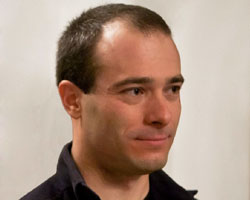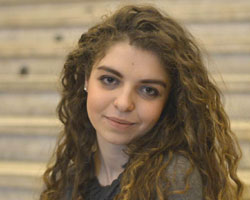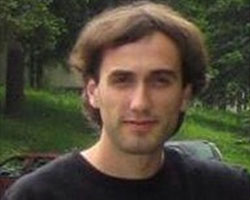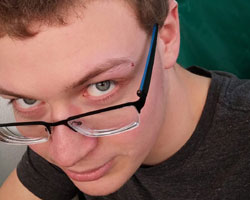To take a picture of what’s invisible and to repair a building this way – it sounds as abstract as Zen and the Art of Motorcycle Maintenance. However, students from the Sofia High School of Mathematics have proven that it is all possible. They have organized a charity exhibition with their own astro-photos. The money collected will go for the repair of Sofia’s astronomic observatory, as it hasn’t been repaired for decades. Associate Prof. Evgeni  Ovcharov, head of the Astronomy Dept. with the Sofia University’s faculty of physics explained that the institution’s board was trying to cope with some of the most urgent repair works with its own funds. Students, PhDs and volunteers have joined the action.The observatory is the oldest in the Balkan Peninsula and it has 120 years of history, Associate Prof. Ovcharov says and adds:
Ovcharov, head of the Astronomy Dept. with the Sofia University’s faculty of physics explained that the institution’s board was trying to cope with some of the most urgent repair works with its own funds. Students, PhDs and volunteers have joined the action.The observatory is the oldest in the Balkan Peninsula and it has 120 years of history, Associate Prof. Ovcharov says and adds:
“It has been a monument of culture since 1976. We use it for training and the popularization of astronomy. It is situated on a very nice spot in the centre of the Borisova Garden and people show curiosity towards astronomy. We try to satisfy that curiosity.”
The students recall how the idea on the exhibition was born spontaneously:
 “We wanted to help the building and since Teodor has this incredible talent in the sphere of astrophotography we decided to combine both things,” says Raya Dimitrova, a student at the school of mathematics and one of the event’s organizers. “Many of the visitors were surprised by the fact that the objects they saw in the pictures were real. Some of them even claimed that computer technologies and programs had been used. They were very impressed and most of them wanted to have and buy some of the photos.”
“We wanted to help the building and since Teodor has this incredible talent in the sphere of astrophotography we decided to combine both things,” says Raya Dimitrova, a student at the school of mathematics and one of the event’s organizers. “Many of the visitors were surprised by the fact that the objects they saw in the pictures were real. Some of them even claimed that computer technologies and programs had been used. They were very impressed and most of them wanted to have and buy some of the photos.”
 PhD with the Astronomy Dept. Gancho Ganchev, one of the participants in the exhibition says that astrophotography shows things which actually exist around us, but we don’t have the ability to see:
PhD with the Astronomy Dept. Gancho Ganchev, one of the participants in the exhibition says that astrophotography shows things which actually exist around us, but we don’t have the ability to see:
“Our eyes are pretty weak detectors, compared to photo cameras and we photograph longer, in order to get more details and information. Sometimes we use tripods, synchronized with the Earth’s spinning, in order for the object to remain in contrast. We gathered photos of astronomic objects and also astrological landscapes, combining night landscapes with the night sky for the exhibition. I think it all went very well.”
 Teodor Alexiev is one of the main engines and participants in the exhibition and according to his coevals he has great talent in the area of photography. The boy says that the long waiting is the main challenge for this type of photography:
Teodor Alexiev is one of the main engines and participants in the exhibition and according to his coevals he has great talent in the area of photography. The boy says that the long waiting is the main challenge for this type of photography:
“Gancho and I have sometimes spent even 6 hours in snow, ice and cold, in order for the photo to be taken. However, pleasant surprises happen as well – for instance, in 2013 I witnessed the explosion of a new star. I observed it all through lens. Later on I had the chance to take a photo of a comet. The photo was also part of the exhibition.”
English version: Zhivko Stanchev
An initiative committee led by the historian Georgi Markov, has proposed that a monument to Khan Asparuh, the founder of the Bulgarian state, be erected on the site of the former Soviet Army Monument in Sofia, in order to serve as a unifying symbol for..
The Bulgarian dance group “Dilmana” based in Copenhagen will celebrate 15 years since its establishment with a celebration on October 18, the formation informed on its Facebook page. Dance group Dilmanа from Copenhagen to perform at the folklore..
A photo exhibition called “Bosilegrad Before and Now – 2” will open on October 13 at the Municipal Art Gallery in the town of Karlovo. The photo exhibition contains 40 panels with motifs and landscapes from Bosilegrad, Serbia, and several Bosilegrad..
Veliko Tarnovo is hosting the Urban Wine Fest, organised by the Bulgarian Association of Wine Professionals. "October is the month of Bulgarian wine and..
Sofia is hosting the finals of ER Champ 2025 — described by the organisers as the world’s largest international escape room competition . Taking place on..
More than 500 people from across Bulgaria are gathering today in the village of General Todorov, near Petrich, for the national festival “Once Upon a..

+359 2 9336 661
